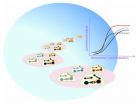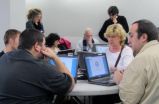(Press-News.org) A new protein biomarker test platform developed by researchers at the University of Michigan and Indiana University promises to improve diagnostic testing. The test can accurately and simultaneously measure multiple proteins that indicate the presence of diseases like graft-versus-host disease (bone marrow transplant rejection) in only two hours, no washing steps, and using only a minute volume of blood plasma. A report on this new technology can be found online in the journal TECHNOLOGY.
The protein test uses a micropatterning method developed in Shuichi Takayama's Micro/Nano/Molecular Biotechnology Lab. "Just as oil and water remain immiscible, we use two aqueous solutions that do not mix with each other," said Dr. Takayama, Professor of Biomedical Engineering and Macromolecular Science and Engineering. "Interestingly, these solutions can be patterned into arrays, whereas standard no-wash protein test reagents normally just mix together in solution. This novel capability makes it possible, for the first time, to measure multiple diagnostic proteins at a time in a no-wash format test."
To perform the assay, a few microliters of blood plasma is mixed with poly(ethylene glycol) and added to a microwell in a custom 384-well microplate. Next, microdroplets of dextran, containing complimentary pairs of antibody-beads, are dispensed into microbasins within the sample well. During a two-hour incubation, target plasma protein biomarkers diffuse from the poly(ethylene glycol) phase to the dextran droplets and become sandwiched by the antibody beads. The microplate is then read on a commercially available plate reader.
The team demonstrated the effectiveness of their bioassay by measuring protein biomarkers from cytokine-stimulated cells, as well as from the plasma of bone marrow transplant patients. Detecting levels of proinflammatory cytokines and chemokines in blood plasma can be crucial in the diagnosis of graft-versus-host disease (GVHD) - the leading cause of death among allogeneic bone marrow transplant patients.
"We envision that our user-friendly and highly accurate platform will be widely used by academic and clinical researchers for diagnostics as well as other applications," said Arlyne Simon, Ph.D., the lead author on this publication. "To ease the adoption of our technology into research and clinical labs, we designed custom microplates that can be analyzed by commercially available plate readers."
INFORMATION:
Additional coauthors of the TECHNOLOGY paper are John P. Frampton, Nien-Tsu Huang, Katsuo Kurabayashi and Sophie Paczesny. This research was funded by the Coulter Translational Research Grant from the University of Michigan, the National Science Foundation, Amy Strelzer Manasevit Research Program, the Defense Threat Reduction Agency and Space and Naval Warfare Command Pacific.
Corresponding author for this study in TECHNOLOGY is Arlyne Simon, arlynes@umich.edu. The study can be read at the following URL: http://www.worldscientific.com/doi/abs/10.1142/S2339547814500150
Aqueous two-phase systems enable multiplexing of homogeneous immunoassays
2014-07-16
ELSE PRESS RELEASES FROM THIS DATE:
Tracking the breakup of Arctic summer sea ice
2014-07-16
As sea ice begins to melt back toward its late September minimum, it is being watched as never before. Scientists have put sensors on and under ice in the Beaufort Sea for an unprecedented campaign to monitor the summer melt.
The international effort hopes to figure out the physics of the ice edge in order to better understand and predict open water in Arctic seas.
"This has never been done at this level, over such a large area and for such a long period of time," said principal investigator Craig Lee, an oceanographer at the University of Washington's Applied Physics ...
Breast cancer: DMP is largely consistent with guidelines
2014-07-16
On 16 July 2014 the German Institute for Quality and Efficiency in Health Care (IQWiG) published the results of a literature search for evidence-based clinical practice guidelines on the treatment of people with breast cancer. The aim of the report is to identify those recommendations from current guidelines of high methodological quality that may be relevant for the planned revision of the disease management programme (DMP). According to the results of the report, there is no compelling need for revision of any part of the DMP. However, IQWiG identified some aspects that ...
Self-assembling nanoparticle could improve MRI scanning for cancer diagnosis
2014-07-16
Scientists have designed a new self-assembling nanoparticle that targets tumours, to help doctors diagnose cancer earlier.
The new nanoparticle, developed by researchers at Imperial College London, boosts the effectiveness of Magnetic Resonance Imaging (MRI) scanning by specifically seeking out receptors that are found in cancerous cells.
The nanoparticle is coated with a special protein, which looks for specific signals given off by tumours, and when it finds a tumour it begins to interact with the cancerous cells. This interaction strips off the protein coating, ...
Improving tumour radiation therapy: When basic ions break DNA down
2014-07-16
Scientists now have a better understanding of how short DNA strands decompose in microseconds. A European team found new fragmentation pathways that occur universally when DNA strands are exposed to metal ions from a family of alkaline and alkaline earth elements. These ions tend to replace protons in the DNA backbone and at the same time induce a reactive conformation leading more readily to fragmentation. These findings by Andreas Piekarczyk, from the University of Iceland, and colleagues have been published in a study in EPJ D. They could contribute to optimising cancerous ...
Researchers advance understanding in immune response to infectious disease
2014-07-16
University of Leicester researchers have released evidence substantiating an unexpected dual role of an important component of the immune system.
Findings by researchers at the University's Department of Infection, Immunity and Inflammation – including three PhD graduates – are published in a paper for the journal 'Medical Microbiology and Immunology'.
The paper presents significant new findings about the protein properdin – an important part of the immune system. It is a positive regulator in the alternative pathway of complement activation – which means it plays a ...
What increases the neuronal plasticity of endogenous NSCs after focal cerebral ischemia?
2014-07-16
Stem cells can substitute the lost cells after central nervous system injury, decrease nervous tissue damage and promote neurofunctional recovery. Many brain injury models, including middle cerebral artery occlusion and traumatic brain injury models, have confirmed that neural stem cells (NSCs) can migrate from subventricular zone to injured cerebral cortex. But the mechanism underlying activation of endogenous NSCs in the ischemic brain remains unclear. Dr. Hyung-Seok Kim, Chonnam National University Medical School, Korea and his team revealed that NSCs were activated ...
Age-related changes in lateral ventricular width and periventricular white matter by DTI
2014-07-16
Ventricular enlargement has been suggested as a structural biomarker for normal aging and progression of some illnesses, such as Alzheimer's disease. However, the question of how this structural change in the brain in normal elderly affects change of white matters remains a topic of interest and concern. Dr. Sang Seok Yeo, College of Medicine, Yeungnam University, Republic of Korea, and his team performed a diffusion tensor imaging (DTI) study to investigate the question. They detected four regions of interest in the periventricular white matter of 60 normal subjected aged ...
Does intravenous transplantation of BMSCs promote neural regeneration after TBI?
2014-07-16
The brain has a low renewable capacity for self-repair and generation of new functional neurons in the treatment of trauma, inflammation and cerebral diseases. Cytotherapy is one option to regenerate central nervous system that aim at replacing the functional depleted cells due to traumatic brain injury (TBI). Bone marrow mesenchymal stem cells (BMSCs) are also considered a candidate for cytotherapy because they can differentiate into neurons/nerve cells, pass across blood-brain barrier, migrate into the injured region, secrete neurotrophic factor, and provide microenvironment ...
Cooperation among humans, a question of age
2014-07-16
This news release is available in Spanish.
The new research paper, which reports on one of the first experimental studies in the world to analyze how cooperative attitudes evolve in different age ranges, was written by the professors from the OpenSystems research group of the Department Fundamental Physics at the Universidad de Barcelona (UB), Josep Perelló and Mario Gutiérrez-Roig, Anxo Sánchez, of the Complex Systems Interdisciplinary Group (Grupo Interdisciplinar de Sistemas Complejos - GISC) of the Mathematics Department at the Universidad Carlos III de ...
Zhichan decoction increases dopaminergic neurons from transplanted NSCs in PD
2014-07-16
There is an increasing interest in Parkinson's disease (PD) treatment by increasing dopamine content and reducing dopaminergic metabolites in the brain. Xuming Yang, Shanghai Municipal Hospital of Traditional Chinese Medicine, China and his team detected dopamine content and dopaminergic metabolites in the midbrain of PD rats, which were treated by neural stem cell (NSC) transplantation and Zhichan decoction administration, using high-performance liquid chromatography, and determined global optimization of dihydroxyphenylacetic acid and homovanillic acid levels using genetic ...

